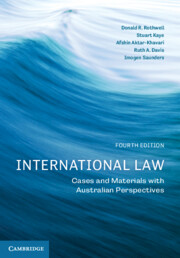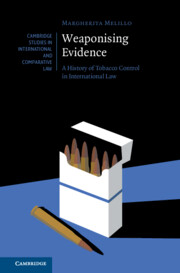Refine search
Actions for selected content:
70 results
4 - Processes of Legalisation in the United Nations
-
- Book:
- Making and Breaking the Rules in Business and Human Rights
- Published online:
- 13 December 2025
- Print publication:
- 22 January 2026, pp 165-239
-
- Chapter
- Export citation
8 - The Turning (1971)
-
- Book:
- Waging Peace
- Published online:
- 03 November 2025
- Print publication:
- 13 November 2025, pp 328-366
-
- Chapter
- Export citation
3 - A Temporary Solution
-
- Book:
- In the Shadow of the Vatican
- Published online:
- 23 October 2025
- Print publication:
- 06 November 2025, pp 91-122
-
- Chapter
- Export citation
7 - Dispossession by Treaty, Dispossession by Statute
- from Part II - Australia, Canada, and New Zealand
-
-
- Book:
- Land Rights Now
- Published online:
- 06 September 2025
- Print publication:
- 25 September 2025, pp 149-167
-
- Chapter
-
- You have access
- Open access
- HTML
- Export citation

International Law
- Cases and Materials with Australian Perspectives
-
- Published online:
- 26 July 2025
- Print publication:
- 31 July 2025
-
- Textbook
- Export citation
13 - International Legitimacy and International Authority
- from Part IV - Construction of Legitimacy in International Law
-
- Book:
- The Law and Politics of International Legitimacy
- Published online:
- 14 July 2025
- Print publication:
- 24 July 2025, pp 242-256
-
- Chapter
- Export citation
Contracts, Treaties and Relationships: Collective Debt, Collective Responsibility and Contractarian Confusions
-
- Journal:
- Canadian Journal of Political Science/Revue canadienne de science politique / Volume 58 / Issue 2 / June 2025
- Published online by Cambridge University Press:
- 09 June 2025, pp. 319-338
-
- Article
- Export citation
U.S. Accession to the Law of the Sea Convention? A Challenge for America's Global Leadership
-
- Journal:
- Asia-Pacific Journal / Volume 15 / Issue 13 / July 2017
- Published online by Cambridge University Press:
- 14 March 2025, e1
-
- Article
-
- You have access
- Open access
- Export citation
3 - Seismic Shocks
-
- Book:
- Tokyo
- Published online:
- 06 February 2025
- Print publication:
- 30 January 2025, pp 43-67
-
- Chapter
- Export citation
Chapter 5 - Hannibal Frustrated in Italy, 216–208
-
- Book:
- Hannibal and Scipio
- Published online:
- 05 September 2024
- Print publication:
- 26 September 2024, pp 137-154
-
- Chapter
- Export citation
Chapter 6 - Overseas Commands
-
- Book:
- Hannibal and Scipio
- Published online:
- 05 September 2024
- Print publication:
- 26 September 2024, pp 155-171
-
- Chapter
- Export citation
1 - Introduction to International Organizations
-
- Book:
- International Organizations
- Published online:
- 17 May 2024
- Print publication:
- 06 June 2024, pp 1-16
-
- Chapter
- Export citation
2 - Baxter’s Paradox and the Customary Prohibition of the Use of Force
- from Part I - Treaty versus Custom
-
- Book:
- Prohibited Force
- Published online:
- 23 February 2024
- Print publication:
- 29 February 2024, pp 30-58
-
- Chapter
-
- You have access
- Open access
- HTML
- Export citation
2 - The Negotiation of the WHO Framework Convention on Tobacco Control
-
- Book:
- Weaponising Evidence
- Published online:
- 11 January 2024
- Print publication:
- 01 February 2024, pp 31-113
-
- Chapter
- Export citation
I.37 - A Treaty between King Æthelred II (‘the Unready’) and Three VikingLeaders
- from Tenth Century
-
- Book:
- The Cambridge Anthology of British Medieval Latin
- Published online:
- 11 January 2024
- Print publication:
- 01 February 2024, pp 396-400
-
- Chapter
- Export citation

Weaponising Evidence
- A History of Tobacco Control in International Law
-
- Published online:
- 11 January 2024
- Print publication:
- 01 February 2024
6 - Do International Agreements Have a Consent Problem?
- from Part II - Objects and Types of Consent
-
-
- Book:
- Consenting to International Law
- Published online:
- 23 November 2023
- Print publication:
- 07 December 2023, pp 137-162
-
- Chapter
- Export citation
2 - State Consent and the Legitimacy of International Law
- from Part I - Notions and Roles of Consent
-
-
- Book:
- Consenting to International Law
- Published online:
- 23 November 2023
- Print publication:
- 07 December 2023, pp 49-71
-
- Chapter
- Export citation
The AU Free Movement Protocol: Challenges in Its Implementation
-
- Journal:
- Journal of African Law / Volume 68 / Issue 1 / February 2024
- Published online by Cambridge University Press:
- 22 November 2023, pp. 3-17
- Print publication:
- February 2024
-
- Article
- Export citation
6 - Negotiations
- from Part II - Navigating Sites
-
-
- Book:
- Conducting Research on Global Environmental Agreement-Making
- Published online:
- 07 August 2023
- Print publication:
- 10 August 2023, pp 93-120
-
- Chapter
- Export citation
